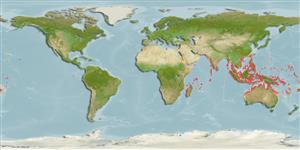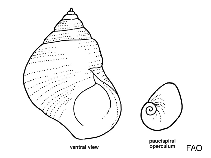Littoraria pallescens (Philippi, 1846)
| Native range | All suitable habitat | Point map | Year 2050 |

|
| This map was computer-generated and has not yet been reviewed. |
| Littoraria pallescens AquaMaps Data sources: GBIF OBIS |
Envoyez vos Photos
Images Google | No image available for this species;
drawing shows typical species in Littorinidae.
Images Google | No image available for this species;
drawing shows typical species in Littorinidae.
Classification / Names Common names | Synonyms | CoL | ITIS | WoRMS
| Littorinimorpha | Littorinidae
Environment: milieu / climate zone / depth range / distribution range Écologie
; saumâtre; profondeur 0 - 22 m (Ref. 100692). Tropical; 26°N - 36°S, 24°E - 167°W
Distribution Pays | Zones FAO | Écosystèmes | Occurrences | Introductions
Indo-Pacific.
Length at first maturity / Taille / Poids / Âge
Maturity: Lm ? range ? - ? cm
Depth range is based on occurrence in Papua New Guinea (Ref. 100692); to be replaced with a better reference. It is found on the upper foliage and trunk (Ref. 112937) of mangroves R. apiculata, R. mucronata, A. alba, A. marina, S. griffithii, S. alba, L. racemosa, C. decandra, C. tagal, B. cylindrical, X. granatum, A. rontundifolia and the palm Nypa fruticans (Ref. 110211).
Life cycle and mating behavior Maturité | Reproduction | Frai | Œufs | Fécondité | Larves
Members of the order Neotaenioglossa are mostly gonochoric and broadcast spawners. Life cycle: Embryos develop into planktonic trocophore larvae and later into juvenile veligers before becoming fully grown adults.
Référence principale
Références | Coordinateur | Collaborateurs
Smith, B.D. 2003. (Ref. 3116)
Statut dans la liste rouge de l'IUCN (Ref. 130435)
statut CITES (Ref. 108899)
Not Evaluated
CMS (Ref. 116361)
Not Evaluated
Menace pour l'homme
Harmless
Utilisations par l'homme
| FishSource |
Outils
Plus d'informations
Pays
Zones FAO
Écosystèmes
Occurrences
Introductions
Stocks
Écologie
Régime alimentaire
Éléments du régime alimentaire
Zones FAO
Écosystèmes
Occurrences
Introductions
Stocks
Écologie
Régime alimentaire
Éléments du régime alimentaire
Taille/Âge
Croissance
Longueur-poids
Longueur-longueur
Morphologie
Larves
Abondance
Croissance
Longueur-poids
Longueur-longueur
Morphologie
Larves
Abondance
Sources Internet
BHL | BOLD Systems | CISTI | DiscoverLife | FAO(Publication : search) | Fishipedia | GenBank (genome, nucleotide) | GloBI | Gomexsi | Google Books | Google Scholar | Google | PubMed | Arbre de Vie | Wikipedia (Go, chercher) | Zoological Record
Estimates based on models
Preferred temperature
(Ref. 115969): 26.7 - 29.3, mean 28.7 (based on 2431 cells).



